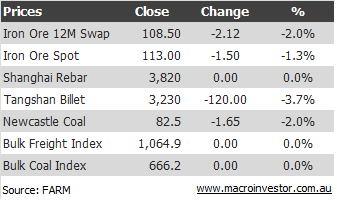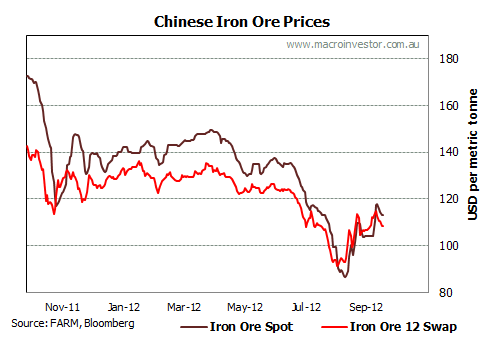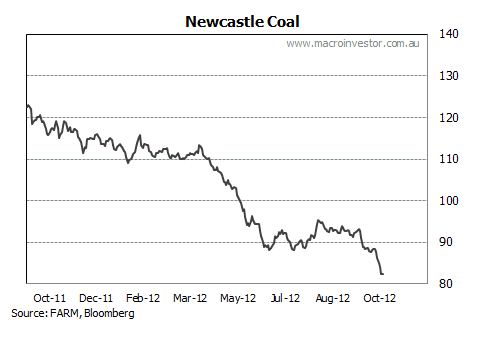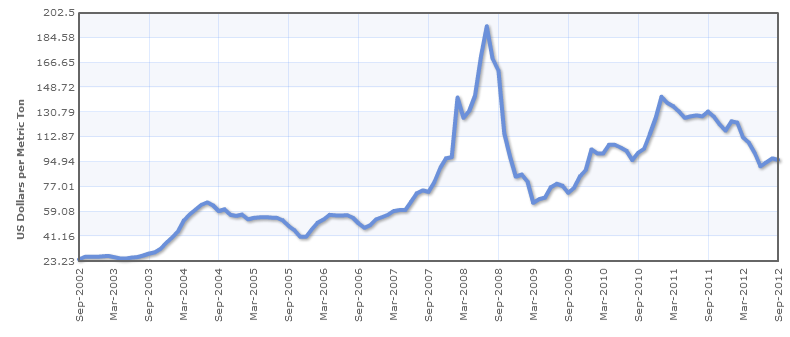
Another poor day for the ore price. More uncomfortable was that Chinese steel prices reversed. Though it was worse still for thermal coal.
Here is the ore chart:

And thermal coal explores the wrong side of the tracks:

Here’s a longer term chart:

That looks like another massive head shoulders pattern to me (and this chart is bit dated, it has already busted the neckline). GFC lows here we come. A lot of the national angst surrounding China’s new normal has been focused on the iron ore price. But between them, coking and thermal coal are almost as large an export. There has been no rebound in coking and thermal is toast.
On iron ore, the piece of the night goes to FTAlphaville, which nicely summarises where the market is at:
It could be because the ‘cost curve’ and the ‘price floor’ are kicking in. But we doubt it – or at least, we think it is way too early to draw that conclusion. And not just because that would mean we were wrong to knock the whole cost curve/$120 floor concept(although stranger things have happened).
As regular AV readers will reccall, we’ve been sceptical of the belief that China’s demand for steel will be pulled ever-upward by the country’s (supposedly) inevitable urbanisation and per capita-GDP growth, mainly based around the work by Nomura’s Matthew Cross but also the broader views of China’s economic development held by Michael Pettis. Both would say the assumption relies on a circular argument: “China will grow because China will grow”, or because some other countries have grown, or because it has grown in the past.
In the shorter term, Cross suggested in the past few months that the falling prices for Chinese steel was a bearish signal for iron ore.
But prices are up, now. And while some steel plants certainly cut production, the cuts didn’t appear to be widespread. The most popular explanation is that mills were running down their inventory of iron ore and now they’re having to re-stock after overshooting.
So what does Cross have to say about that?
He has what he admits is just a theory, but it’s one that we think is plausible. He forwarded us some notes he’s been sending to clients.
Firstly, he says, yes there is some restocking going on for sure. But some mills — particularly small and medium ones — don’t appear to want to restock to the historically high levels of iron ore inventory they held over the past few years. This is why:
1) The past 2-3 years with raw material prices only going up, mills made more money holding iron ore inventories in a rising price environment than they did by making steel – so they were effectively paid to hold as much iron ore as possible. But this has now reversed – with steel demand stagnating it is becoming increasingly obvious to all that raw material supply is growing faster than steel production and prices are falling. Holding excessive raw materials when prices are falling is a fast way to lose money, mills are now incentivized to hold as little ore as possible; and2) Mills are short capital because they are breakeven/loss making, but no one wants to cut production – holding less raw material inventory is a very easy and efficient way to raise capital.Cross writes of an example: a small private sector steel mill which has tended to hold 40 – 50 days worth of iron ore over the past few years.Over the past 6 weeks they destocked to 10 days and then back up to 20 days, and they said 20 days of iron ore is more than enough and is the “new normal”. By doing this they’ve effectively had a $100mn capital raising […] 8mtpa of production needs a bit more than 12mtpa of iron ore – destocking from 50 to 20 days takes 1mt of iron ore of his balance sheet, at $100/t x 1mt that’s $100mn of working capital freed up. Flexing his working capital has given him an extra $100mn.
But let’s say that this shift to lower inventory is widespread and permanent. Won’t everything return to normal, once equilibrium is reached around the permanently lower inventories?Maybe. But remember that the demand seen in recent years is very much connected to the stimulus launched in 2008/09. If you can find a strategist (or better yet, an industry player) willing to bet that China’s central government will embark upon another stimulus anything like the scale of that which began in 2008/09, do let us know. Yes, the ‘price floor’ could activate via those expensive Chinese iron ore producers dropping out of the market. But they are only likely to do so if the pricesremain below their ~$120 breakeven point. In effect, the floor is more like a ceiling.So, if this iron ore destocking/capital raising has allowed some steelmakers to keep the mills running — effectively subsidising their loss-making production during a downturn — it also means that they won’t have that option next time steel demand falls (assuming it has actually bounced back in the first place).In that scenario, production cuts may be more apparent.

